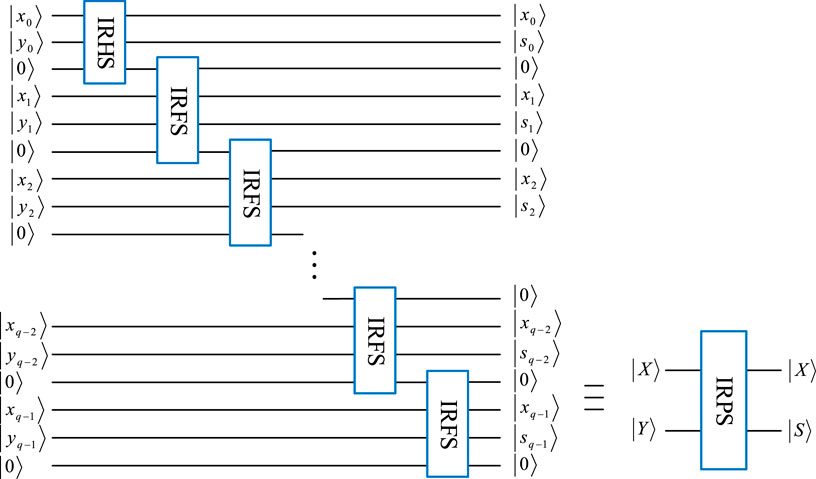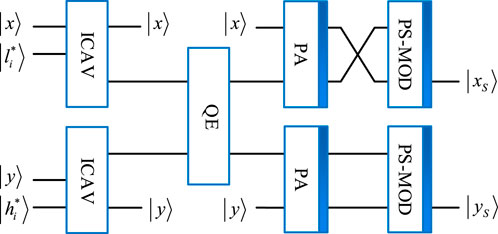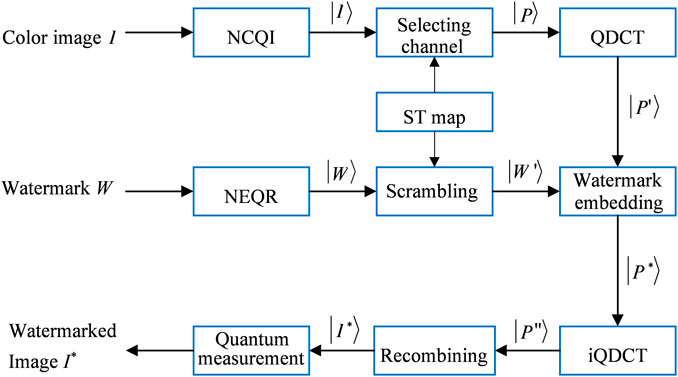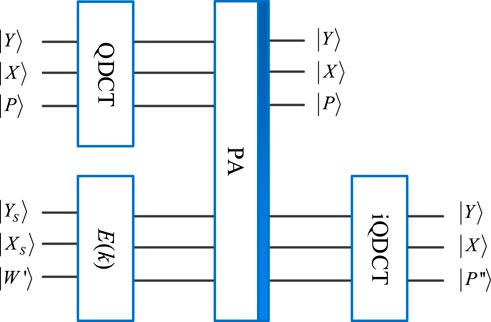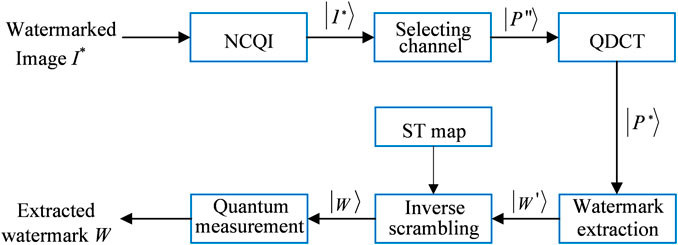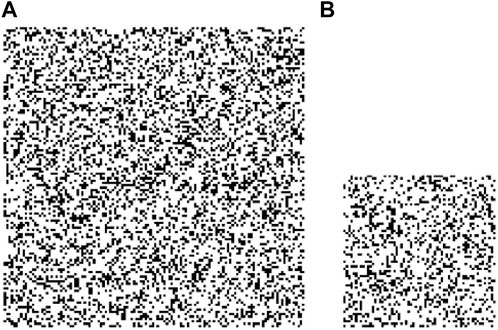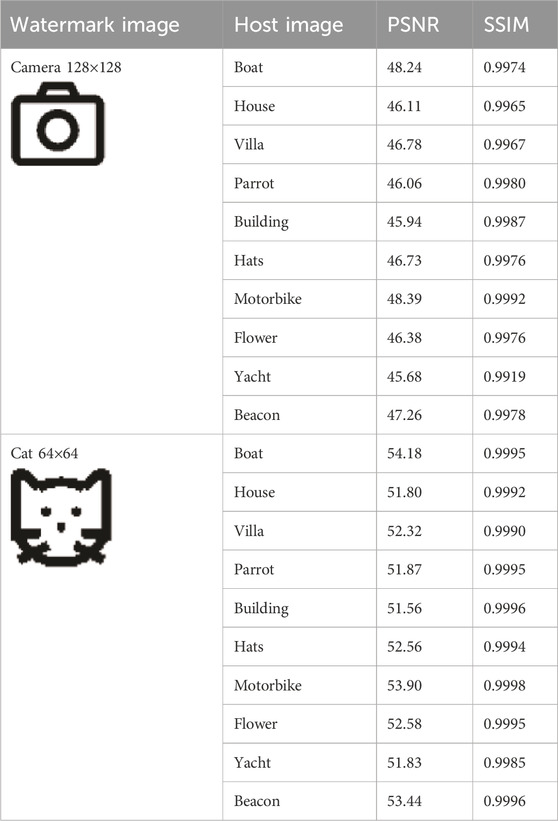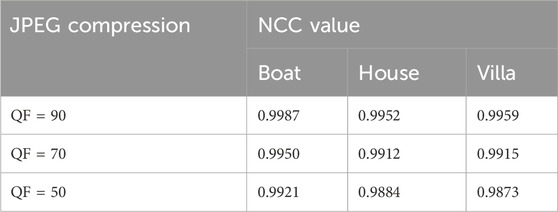- 1College of Science and Technology, Nanchang University, Jiujiang, China
- 2Department of Electronic Information Engineering, Nanchang University, Nanchang, China
- 3School of Electronic and Electrical Engineering, Shanghai University of Engineering Science, Shanghai, China
To overcome the drawbacks of the existing sinusoidal map and tent map, this paper proposes the design of a sinusoidal–tent (ST) map. The test results indicate that the new chaotic system exhibits more significant advantages in chaos control. Compared with the sinusoidal map and tent map, the proposed sinusoidal–tent map performs better in terms of bifurcation diagram and Lyapunov exponents. The trajectories of the sinusoidal–tent map can occupy all the phase planes over (0,4), while those of the two classic maps only occupy a small phase space, and the Lyapunov exponents of the ST map are all positive within the range of control parameters, higher than those of seed maps. Simultaneously, a novel quantum scrambling operation is devised based on the sinusoidal–tent map to avoid the periodicity of the quantum Arnold scrambling method. Initially, two chaotic sequences are generated to scramble the pixel positions of the watermark image, further enhancing the security of the watermarking algorithm. Subsequently, the host image is processed by the quantum discrete cosine transform, and finally, the scrambled watermark image is inserted into the medium-frequency band of the transformed host image, ensuring the invisibility of the watermarking. According to the simulation results, the quantum watermarking algorithm has excellent invisibility and robustness.
1 Introduction
Information security is indeed a crucial field in the era of big data. Image information security is one of its significant branches that have witnessed rapid development over the past few decades [1–5]. Particularly, benefiting from the entanglement characteristics and the powerful parallel computing abilities, quantum computing has the potential to overcome the limitations of classical computation. Quantum computing is a computational model that employs quantum bits, utilizing the principles of quantum mechanics to process information. Traditional computers use bits (0 or 1) as the smallest units for storage and processing, while quantum computers use quantum bits, often referred to as “qubits.” Qubits can not only represent the states of 0 and 1 but also exist in superstitions of these states, a key aspect of quantum parallelism [6].
During signal transmission, the computing complexity of quantum operations has been effectively reduced, thereby significantly increasing information security through quantum computing. Beach et al. [7] highlighted and analyzed the doubts surrounding quantum image processing, demonstrating the true quantum superiority in quantum image classification and recognition. To improve the fault tolerance of quantum circuits, Li et al. [8] implemented cyclic and complete translations on quantum images through quantum arithmetic operations and realized the scalar matrix multiplication by designing fault-tolerant circuits for these operations with the TR and Peres gates. The mid-point filter, which is an order statistic filter, cannot be directly used in the frequency domain. As a solution, Ali et al. [9] introduced a new quantum mid-point filter designed specifically for spatial domain applications. This proposed approach maintains the same level of noise suppression as the classical version but significantly reduces the complexity.
For different purposes, various representation models of quantum images have been investigated [10–14]. The first flexible representation of the quantum image (FRQI) was invented to encode the position information and color information of an image into a single quantum state [10]. A novel enhanced quantum representation (NEQR) was explored to quadratically speed up the preparation of quantum images and enhance the compression ratio of quantum images [11]. The radiation energy value of a pixel in infrared images could be stored using the probability of projection measurement [12]. A quantum scaling-up algorithm for images was proposed using nearest-neighbor interpolation [14]. In addition, researchers have also developed several models for quantum color image representation, such as NCQI [15], MQIR [16], and DQRCI [17].
Digital watermarking is a technique that embeds specific information within digital media, with the aim of verifying or identifying the authenticity, ownership, or source of digital content. This technology is commonly used in digital media files such as images, audio, and videos [18]. To address the security issue in copyright protection, various watermarking strategies have been explored [19, 20]. Gong et al. [19] proposed a watermarking scheme for double-color images, which involved the use of quaternion fractional-order orthogonal Fourier–Mellin moments and geometric correction. Different from classical watermarking algorithms, quantum watermarking algorithms (QWAs) combine principles of quantum computation theory and watermarking strategies [20, 21]. A quantum watermarking scheme was enhanced by utilizing the novel enhanced quantum representation (NEQR) along with a color scrambling technique and small-scale quantum circuits [22]. In order to improve the visual quality and embedding capacity, Zeng et al. [23] proposed a quantum watermarking algorithm by combining the maximal pixel difference with the tent map. A self-recovery QWA was devised with block truncation coding to increase the key space and improve security [24]. In 2021, Li et al. [25] proposed a quantum watermarking scheme for the quantum hue, saturation, and lightness (QHSL) image in the spatial domain. The scheme aimed to protect the integrity and ownership of QHSL images against various attacks. A QWA was presented with the quantum Fourier transformation [26]. Similarly, a quantum image watermarking algorithm was investigated by the quantum Haar wavelet transform [27]. The discrete cosine transform (DCT) is a Fourier-related transform similar to the discrete Fourier transform but using only real numbers [28]. The utilization of DCT shifts an image from the time domain to the frequency domain, where most of the signal information is focused on the low-frequency bands situated in the upper-left corner. DCT is frequently employed for lossy compression, as seen in the JPEG compression of digital images and the MP3 compression of digital audio, owing to its robust energy compaction features. Simultaneously, DCT coefficients in the high-frequency bands, located in the lower-right corner, are nearly zero. Building upon the aforementioned characteristics of the DCT, Mohsen et al. [29] proposed a quantum watermarking algorithm for audio using the quantum discrete cosine transform (QDCT). This algorithm utilizes QDCT, a quantum counterpart of the classical DCT, to achieve enhanced information compression performance inherited from the DCT. Overall, the use of QDCT in audio watermarking offers advantages in terms of imperceptibility and robustness. However, it is important to conduct further research to evaluate the effectiveness and security of QDCT-based QWAs in practical applications and against more sophisticated attacks.
Quantum image scrambling techniques were invented for quantum watermarking due to the superiority of quantum computing models. The quantum Arnold transform is one of the common and available image scrambling methods [30]. However, the risk from the periodicity of the Arnold transform is unavoidable, as attackers can restore the scrambled image with sufficient computing resources. In order to mitigate this risk, a new quantum image scrambling operation using the sinusoidal–tent map is proposed here. This map is a 1D chaotic map which is chosen due to its simple structure and easy implementation. The sinusoidal–tent map exhibits more significant advantages in spatiotemporal performance and chaotic characteristics compared to the sinusoidal map and tent map. Additionally, a quantum color watermarking algorithm is studied by integrating the QDCT with the sinusoidal–tent map, and a quantum network for the proposed quantum image watermark embedding is also devised.
2 Fundamental knowledge
2.1 NCQI model
The NCQI model storing a quantum color image
where
The grayscale value of each channel
2.2 Novel enhanced quantum representation
As a commonly used quantum representation of images, NEQR stores the gray information of each image pixel via the basis state of a qubit sequence, and it performs well because of its accuracy and flexibility. Assume that the gray value of an image pixel ranges from 0 to
A
A quantum binary image of size
where
The calculation of the absolute value (CAV) of two n-qubit sequences can be implemented by integrating the above RPS and CO modules [31].
To determine whether two input quantum sequences
2.3 Quantum discrete cosine transform
The quantum discrete cosine transform on a
Module
3 Quantum color image watermarking scheme
3.1 Improved quantum module
3.1.1 Improved reversible half-subtractor
Figure 2 illustrates the quantum circuits and quantum modules of the proposed improved reversible half-subtractor (IRHS) according to [31]. The IRHS module performs the half-subtraction operation.
3.1.2 Improved reversible full-subtractor
An improved reversible full-subtractor (IRFS) based on [31] is redesigned, as shown in Figure 3. Different from the quantum circuit of RFS, the IRFS module economizes a qubit and one CNOT gate. The IRFS module performs a full-subtraction operation, where the outputs
3.1.3 Improved reversible parallel subtractor
A reversible parallel subtractor (RPS) usually involves RHS and RFS [31], and thus the improved reversible parallel subtractor (IRPS) for
3.1.4 Improved calculation of the absolute value
The quantum module CAV consists of RPS and CO [31]. Figure 5 shows the proposed improved calculation of the absolute value (ICAV), which consists of CO and IRPS. A
3.2 Sinusoidal–tent map
3.2.1 Sinusoidal map
The sinusoidal map is a common one-dimensional chaotic map [33] and is defined as Eq. 9.
where

FIGURE 6. Trajectories of different chaotic maps: (A) sinusoidal map with parameter

FIGURE 7. Lyapunov exponents of different chaotic maps: (A) sinusoidal map with parameter
3.2.2 Tent map
The tent map is a one-dimensional piece-wise linear map [34] and is defined as Eq. 10.
where
3.2.3 Sinusoidal–tent map
By combining the sinusoidal map with the tent map, a sinusoidal–tent map as the new chaotic map is designed as Eq. 11.
where the parameter
3.3 Quantum scrambling with the sinusoidal–tent map
The Arnold scrambling method is insecure with sufficient computing resources owing to its periodicity. Therefore, we put forward a new irregular scrambling method. The scrambling on a quantum image
(1) a and b are chosen as initial parameter values of the sinusoidal–tent map. Then, two chaotic sequences
(2) The original image is then scrambled via the element values of
where
3.4 Watermark embedding procedure
During the watermark embedding process, the color image
Step 1. The classical image
Step 2. With the initial parameter value a of the sinusoidal–tent map, one chaotic sequence
According to Eq. 16, if
Step 3. The original watermark
Step 4. Image
Step 5. The medium-frequency QDCT coefficients of every sub-block are selected randomly and embedded with a quantum image
Step 6. After executing the inverse QDCT on
A quantum watermark embedding network is shown in Figure 10, where
3.5 Watermark extraction
The watermark image is extracted from a watermarked quantum color image with the help of the color host image and the keys to choose the embedded channel and scramble the watermark image. Figure 11 shows the extraction of the designed quantum color image watermarking algorithm, and the extraction process is detailed below.
Step 1. First, in order to extract the watermark image from the host image, the classical watermarked image
Step 2. The chaotic sequence
Step 3. This step is only to perform QDCT on the watermarked image
Step 4 .
Step 5. The sequences
Step 6. After quantum measurement, the quantum watermark image
4 Numerical simulation and discussion
The numerical simulations are carried out under the MATLAB R2017b platform on a classical PC. Ten host color images of size
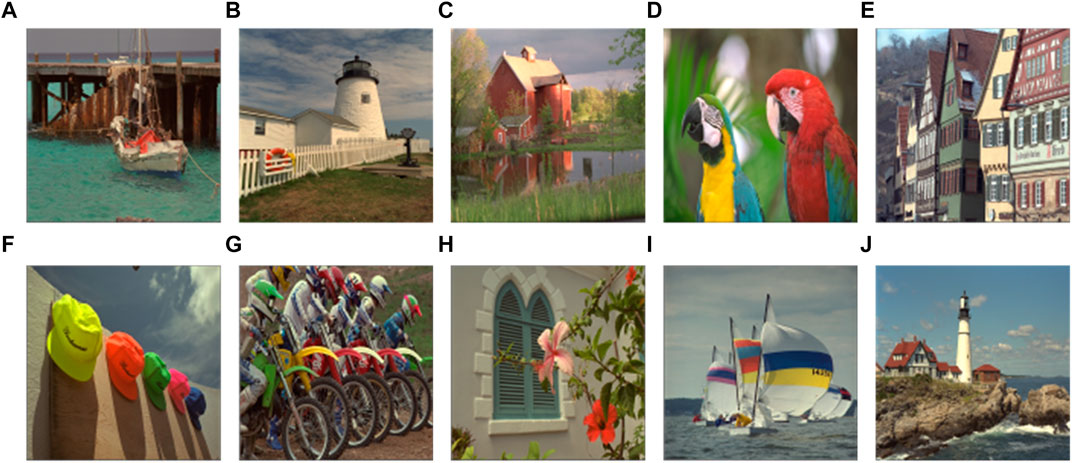
FIGURE 12. Ten selected test images of size
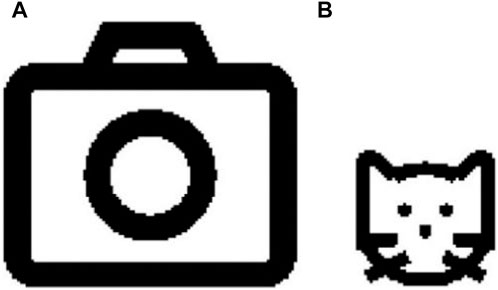
FIGURE 13. Watermark images: (A) “Camera” of size
The scrambling operation S is executed on the watermark image “Camera” and “Cat,” and Figures 14A, B show the corresponding scrambled watermark images. As shown in Figure 14, the proposed scrambling operation has an acceptable scrambling performance.
4.1 Watermark evaluation exponents
The peak signal-to-noise ratio (PSNR) is expressed as Eq. 20.
where
The structural similarity exponent matrix (SSIM) can assess the distortion of an image or the similarity of two images according to Eq. 21:
where
Normalized cross-correlation (NCC) is another important exponent to assess the similarity of two images and is usually employed to measure the robustness of watermarking algorithms against different attacks, which is expressed as Eq. 22.
Here,
4.2 Imperceptibility analysis
Figures 15A–E show the watermarked color images with the watermark image “Camera,” while Figures 15F–I show the watermarked images with the watermark image “Cat.” By observing and comparing Figure 12; Figure 15, it can be observed that there is no significant difference between the watermarked image and the original host image.
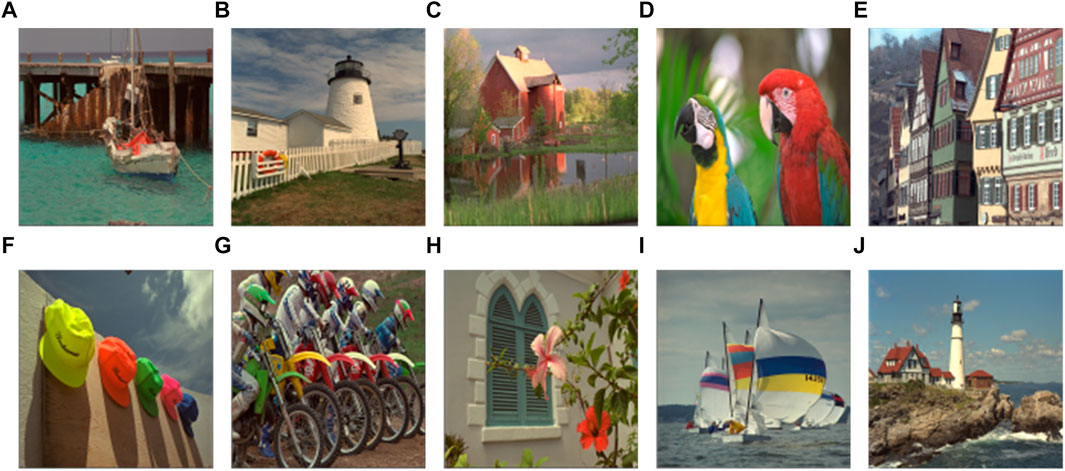
FIGURE 15. Watermarked image with “Camera”: (A) “Boat,” (B) “White house,” (C) “Villa,” (D) “Parrot,” and (E) “Building.” Watermarked image with “Cat”: (F) “Hats,” (G) “Motorbike,” (H) “Flower,” (I) “Yacht,” and (J) “Beacon.” Adapted with permission from [37], licensed by Eastman Kodak Company.
The values listed in Table 1 represent the PSNR and SSIM for the watermark image with two different sizes. The PSNR is mainly used for the evaluation and comparison of image and video compression algorithms and can help measure the impact of different compression algorithms on the quality of images or videos. The higher the value of the PSNR, the smaller the difference between two images, indicating higher quality. Generally, if the PSNR value is greater than 30 dB, it is hard to differentiate between the original host image and the watermarked image. If the PSNR value is greater than 40 dB, then the invisibility of the image watermark algorithm can be ensured. As for the watermark images “Camera” and “Cat,” the average PSNR values of the host image and the watermarked image with the proposed QWA are 46.76 dB and 52.60 dB, respectively. It indicates that the quality of the watermarked image and the corresponding original host image are very close. In addition, the SSIM values of the host image and the watermarked one approach 1. The SSIM value ranges from 0 to 1, where 1 indicates that the two images are identical and 0 indicates that the two images are completely different. A higher SSIM value indicates that the two images are more similar. Therefore, the proposed color image watermark algorithm has good invisibility.
In image processing, histograms are valuable tools for analyzing various image features, such as contrast, brightness, and color distribution. By comparing histograms of different images, we can determine their similarities or differences. For instance, if the histograms of two images are closely matched, it suggests that they may have comparable color distributions, indicating their similarity. In Figure 16, the histogram of the watermarked image is similar to the histogram of the original carrier image. This implies that the pixel intensity distributions of the two images may be similar. This can be considered evidence that the watermark image has been successfully embedded into the original carrier image without significantly altering the pixel distribution characteristics of the images. Figures 16A–C show the histograms of three selected host images: “Boat,” “Villa,” and “Hats,” respectively. Figures 16D–F show the histograms of the associated watermarked images. In Figure 16, the histogram of the watermarked image closely resembles that of the original carrier images. This similarity implies that the pixel intensity distributions of the two images may be comparable. Thus, this similarity serves as evidence that the watermark image has been successfully embedded into the original carrier image without significantly altering its pixel distribution characteristics.
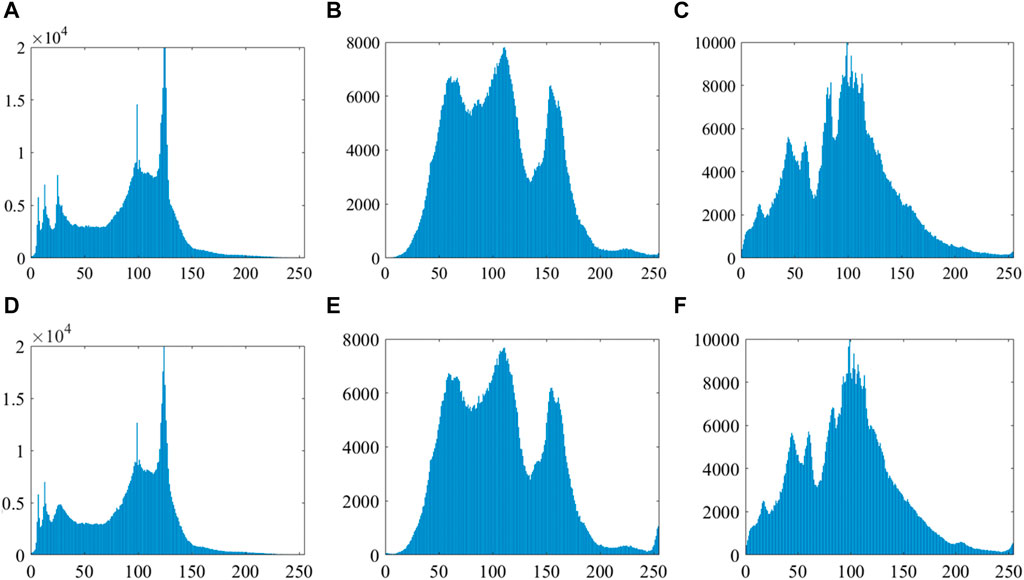
FIGURE 16. (A–C) Histograms of host images “Boat,” “Villa,” and “Hats,” respectively; (D–F) histograms of the corresponding watermarked host images.
4.3 Robustness analysis
The image “Cat” of size
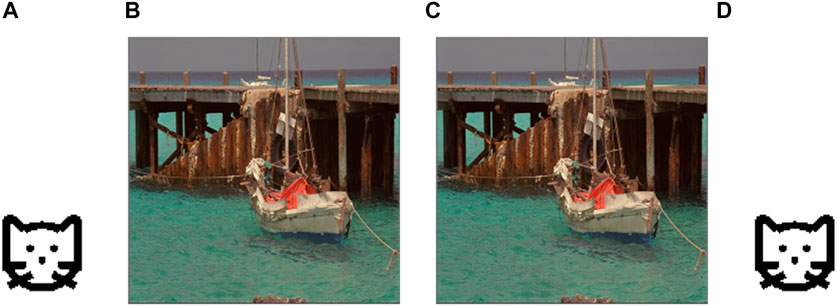
FIGURE 17. (A) Watermark image “Cat,” (B) host image “Boat,” (C) watermarked image, and (D) extracted watermark image. Adapted with permission from [37], licensed by Eastman Kodak Company.
4.3.1 Noise attack
Noise attack is a common method used to test the robustness of algorithms against the addition of noise in images. By conducting noise attack tests, the robustness of image processing algorithms against different intensities and types of noise can be evaluated. Salt-and-pepper noise with densities of 0.01, 0.03, and 0.05 was added to the watermarked image “Boat.” The watermarked images, along with the corresponding extracted watermark images containing the respective noises, are shown in Figure 18. The NCC values of the extracted watermark images with the added noises are shown in Table 2. From Table 2, it can be observed that the proposed QWA performs well in terms of withstanding noise attacks.
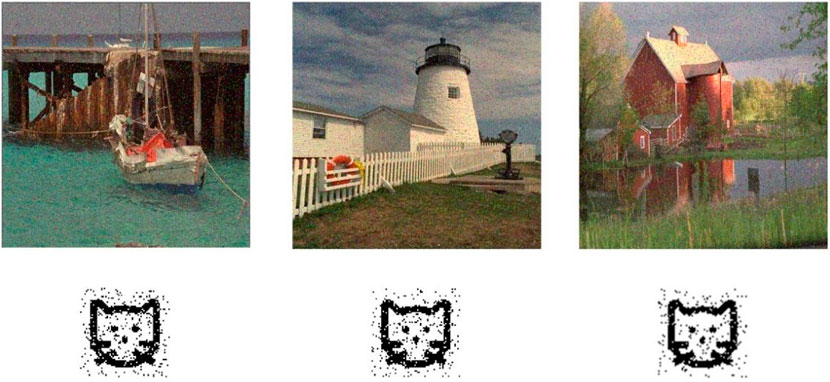
FIGURE 18. Test result of salt-and-pepper noise attack (intensity 0.05). Adapted with permission from [37], licensed by Eastman Kodak Company.
4.3.2 JPEG compression attack
A JPEG compression attack refers to applying different intensities of JPEG compression to an image with an embedded watermark and evaluating the watermark extraction effectiveness in the compressed image. The experimental results of JPEG compression attacks are shown in Table 3. Quality factor parameters used for JPEG compression in the experiment are set to 90, 70, and 50, respectively. Figure 19 shows the watermarked images subjected to different intensities of JPEG compression attacks, along with the corresponding extracted watermark images. Notably, even when the quality factor parameter was set to 50, the extracted watermark images remained complete and clear, with all corresponding NCC values exceeding 0.98. As a result, the presented quantum color image watermarking algorithm demonstrates resistance against JPEG compression attacks.
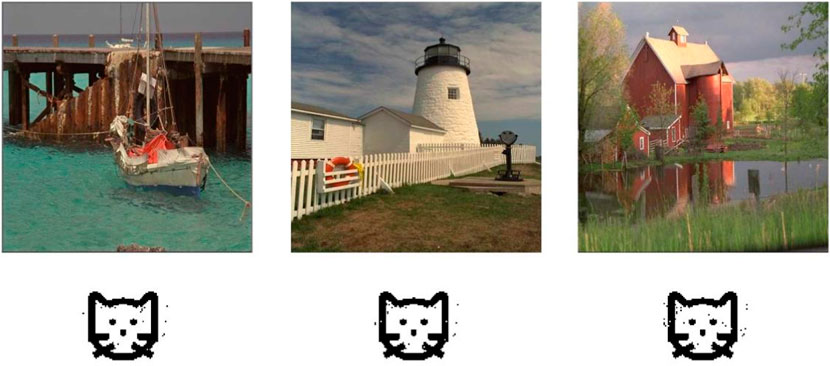
FIGURE 19. Result of JPEG compression attack (QF = 50). Adapted with permission from [37], licensed by Eastman Kodak Company.
4.3.3 Filtering attack
A filtering attack refers to a type of cyber-attack in which an attacker tries to block or filter out certain information or content from reaching its intended recipient. The median filtering with a filtering window
4.4 Comparative analysis
The imperceptibility of the proposed QWA compared with other typical algorithms [21, 35, 36] is shown in Tables 5, 6. Notably, the QWA exhibits superior performance with PSNR and SSIM values when compared to the algorithms referenced in [21, 35, 36]. This enhancement in imperceptibility within the proposed algorithm is attributed to the strategic embedding of the watermark into the medium-frequency component of the transformed host image. By focusing on this frequency range, the QWA achieves a balance between robust watermark insertion and minimizing perceptual impact, thereby ensuring an improved level of invisibility compared to the referenced algorithms. The utilization of the medium-frequency component allows the proposed QWA to maintain the visual quality of the watermarked image while successfully concealing the embedded information.
4.5 Quantum circuit complexity analysis
The complexity of our proposed color image QWA is mainly related to the quantum scrambling operation and the QDCT. The presented quantum scrambling operation can be realized with two ICAV modules, one QE module, two PA modules, and two PS-MOD modules. For an image of size
5 Conclusion and future challenges and directions
5.1 Conclusion
A one-dimensional chaotic map, i.e., a sinusoidal–tent map, is devised by combining the sinusoidal map with the tent map. Depending on the random sequence generated using the sinusoidal–tent map, a new position scrambling operation on a quantum image together with the associated quantum circuit is devised. The original quantum circuits of some existing quantum modules are improved to reduce their complexities. The security of QWA is enhanced by using the sinusoidal–tent map to scramble the watermark image. After the quantum discrete cosine transform, most of the signal energy is concentrated on the low-frequency part; thus, choosing the medium-frequency component to embed watermark can enhance the invisibility and robustness of the algorithm. The experimental results illustrate that the QWA has good invisibility and high robustness against noise attack, JPEG compression attack, and filtering attack.
5.2 Potential future challenges and directions
Currently, the quantum watermark technology is generally implemented by simulating quantum theory on classical computers, and there are no well-developed quantum devices available for testing. Therefore, future challenges lie in continuously adjusting the direction of quantum watermark algorithms to cater to the development of quantum computers. This will require proposing algorithms that are better suited for quantum computer applications. Therefore, the future research directions for quantum watermarking will focus on algorithm development, physical implementation, robustness analysis, and application expansion. By exploring these areas, we can create more opportunities and face new challenges in protecting digital content, enhancing information security, and advancing quantum technology.
Data availability statement
The datasets presented in this article are not readily available. The data and implementation code for MATLAB are available upon request. Requests to access the datasets should be directed to cHB6ZW5nQG5jdS5lZHUuY24=.
Author contributions
P-PZ: conceptualization, funding acquisition, investigation, methodology, validation, and writing–original draft. XZ: formal analysis, software, and writing–original draft. D-FZ: data curation, visualization, and writing–review and editing. S-HC: data curation, validation, and writing–review and editing. L-HG: project administration, supervision, validation, and writing–review and editing.
Funding
The author(s) declare that financial support was received for the research, authorship, and/or publication of this article. This work was supported by the National Natural Science Foundation of China (Grant Nos 62202252 and 61861029), the Science and Technology Planning Project of Shanghai (Grant No. 23010501800), the Science and Technology Research Project of Jiangxi Education Department (GJJ2203915), and the Higher Education Reformation Project of Jiangxi Province (JXJG-22-30-5).
Conflict of interest
The authors declare that the research was conducted in the absence of any commercial or financial relationships that could be construed as a potential conflict of interest.
Publisher’s note
All claims expressed in this article are solely those of the authors and do not necessarily represent those of their affiliated organizations, or those of the publisher, the editors, and the reviewers. Any product that may be evaluated in this article, or claim that may be made by its manufacturer, is not guaranteed or endorsed by the publisher.
References
1. Velayatipour M, Mosleh M, Nejad MY, Kheyrandish M. Quantum reversible circuits for audio watermarking based on echo hiding technique. Quan Inf Process (2022) 21(9):316. doi:10.1007/s11128-022-03657-9
2. Liang Q, Zhu CX. A new one-dimensional chaotic map for image encryption scheme based on random dna coding. Opt Laser Technol (2023) 160:109033. doi:10.1016/j.optlastec.2022.109033
3. Zhou NR, Hu LL, Huang ZW, Wang MM, Luo GS. Novel multiple color images encryption and decryption scheme based on a bit-level extension algorithm. Expert Syst Appl (2023) 238:122052. doi:10.1016/j.eswa.2023.122052
4. Huang ZW, Zhou NR. Image encryption scheme based on discrete cosine Stockwell transform and DNA-level modulus diffusion. Opt Laser Technol (2022) 149:107879. doi:10.1016/j.optlastec.2022.107879
5. Zhou NR, Tong LJ, Zou WP. Multi-image encryption scheme with quaternion discrete fractional Tchebyshev moment transform and cross-coupling operation. Signal Process. (2023) 211:109107. doi:10.1016/j.sigpro.2023.109107
6. Leong K, Sung A. What business managers should know about quantum computing? J Interdiscip Sci (2022) 6(2):42–52.
7. Beach G, Lomont C, Cohen C. Quantum image processing (QuIP). In: 32nd Applied Imagery Pattern Recognition Workshop; 15-17 October 2003; Washington, DC, USA (2003). p. 39–44.
8. Li HS, Fan P, Xia HY, Peng H, Long GL. Efficient quantum arithmetic operation circuits for quantum image processing. Sci China: Phys Mech Astron (2020) 63(8):280311. doi:10.1007/s11433-020-1582-8
9. Ali AE, Abdel-Galil H, Mohamed S. Quantum image mid-point filter. Quan Inf Process (2020) 19(8):238. doi:10.1007/s11128-020-02738-x
10. Le PQ, Dong FY, Hirota K. A flexible representation of quantum images for polynomial preparation, image compression, and processing operations. Quan Inf Process (2011) 10(1):63–84. doi:10.1007/s11128-010-0177-y
11. Zhang Y, Lu K, Gao YH, Wang M. NEQR: a novel enhanced quantum representation of digital images. Quan Inf Process (2013) 12(8):2833–60. doi:10.1007/s11128-013-0567-z
12. Yuan SZ, Mao X, Xue YL, Chen L, Xiong Q, Compare A. SQR: a simple quantum representation of infrared images. Quan Inf Process (2014) 13(6):1353–79. doi:10.1007/s11128-014-0733-y
13. Yan F, Iliyasu AM, Venegas-Andraca SE. A survey of quantum image representations. Quan Inf Process (2016) 15(1):21–35. doi:10.1007/s11128-015-1195-6
14. Jiang N, Wang J, Mu Y. Quantum image scaling up based on nearest-neighbor interpolation with integer scaling ratio. Quan Inf Process (2015) 14(11):4001–26. doi:10.1007/s11128-015-1099-5
15. Sang JZ, Wang S, Li Q. A novel quantum representation of color digital images. Quan Inf Process (2017) 16(2):42. doi:10.1007/s11128-016-1463-0
16. Zhu HH, Chen XB, Yang YX. A multimode quantum image representation and its encryption scheme. Quan Inf Process (2021) 20(9):315. doi:10.1007/s11128-021-03255-1
17. Wang L, Ran QW, Ma J. Double quantum color images encryption scheme based on DQRCI. Multimedia Tools Appl (2020) 79(9):6661–87. doi:10.1007/s11042-019-08514-z
18. Sencar HT, Ramkumar M, Akansu AN. Data hiding fundamentals and applications: content security in digital multimedia. San Diego, CA, USA: Academic Press (2004).
19. Gong LH, Luo HX. Dual color images watermarking scheme with geometric correction based on quaternion FrOOFMMs and LS-SVR. Opt Laser Technol (2023) 167:109665. doi:10.1016/j.optlastec.2023.109665
20. Zhou NR, Luo AW, Zou WP. Secure and robust watermark scheme based on multiple transforms and particle swarm optimization algorithm. Multimedia Tools Appl (2019) 78:2507–23. doi:10.1007/s11042-018-6322-9
21. Wang MX, Yang HM, Jiang DH, Yan B, Pan JS, Wang T. A novel quantum image watermarking scheme for tamper localization and self-recovery. Quan Inf Process (2022) 21(8):277. doi:10.1007/s11128-022-03619-1
22. Li PC, Zhao Y, Xiao H, Cao M. An improved quantum watermarking scheme using small-scale quantum circuits and color scrambling. Quan Inf Process (2017) 16(5):127. doi:10.1007/s11128-017-1577-z
23. Zeng QW, Wen ZY, Fu JF, Zhou NR. Quantum watermark algorithm based on maximum pixel difference and tent map. Int J Theor Phys (2021) 60(9):3306–33. doi:10.1007/s10773-021-04909-7
24. Hemida O, He H. A self-recovery watermarking scheme based on block truncation coding and quantum chaos map. Multimed Tools Appl (2020) 79(25):18695–725. doi:10.1007/s11042-020-08727-7
25. Li NQ, Yan F, Hirota K. Quantum watermarking schemes for QHSL images in spatial domain. 2021 8th international conference on soft computing and machine intelligence (ISCMI). Cario, Egypt (2021) 225–30. doi:10.1109/ISCMI53840.2021.9654956
26. Zhang WW, Gao F, Liu B, Wen QY, Chen H. A watermark strategy for quantum images based on quantum Fourier transform. Quan Inf Process (2013) 12(2):793–803. doi:10.1007/s11128-012-0423-6
27. Zeng QW, Ge HY, Fu JF, Gong L, Zou W. Quantum watermarking algorithm based on quantum Haar wavelet transform and Henon map. Int J Theor Phys (2022) 61(6):167. doi:10.1007/s10773-022-04998-y
28. Ahmed N, Natarajan T, Rao KR. Discrete cosine transform. IEEE Trans Comput (1974) C-23(1):90–3. doi:10.1109/t-c.1974.223784
29. Mohsen YN, Mohammad M, Saeed RH. A blind quantum audio watermarking based on quantum discrete cosine transform. J Inf Security Appl (2020) 55:102495. doi:10.1016/j.jisa.2020.102495
30. Liu XB, Xiao D, Liu C. Three-level quantum image encryption based on Arnold transform and logistic map. Quan Inf Process (2021) 20(1):23. doi:10.1007/s11128-020-02952-7
31. Zhou RG, Hu WW, Luo GF, Liu X, Fan P. Quantum realization of the nearest neighbor value interpolation method for INEQR. Quan Inf Process (2018) 17(7):166. doi:10.1007/s11128-018-1921-y
32. Zhou RG, Hu WW, Fan P. Quantum watermarking scheme through Arnold scrambling and LSB steganography. Quan Inf Process (2017) 16(9):212. doi:10.1007/s11128-017-1640-9
33. Ahmed A, Sridevi S, Hayder K, Ahmadi A, Rajagopal K, Jafari S. A novel multi-stable sinusoidal chaotic map with spectacular behaviors. Commun Theor Phys (2023) 75:115001. doi:10.1088/1572-9494/acf307
34. Zhou YC, Long B, Chen CL. A new 1D chaotic system for image encryption. Signal Process. (2014) 97:172–82. doi:10.1016/j.sigpro.2013.10.034
35. Su QT, Liu DC, Yuan ZH, Wang G, Zhang X, Chen B, et al. New rapid and robust color image watermarking technique in spatial domain. IEEE Access (2019) 7(3):30398–409. doi:10.1109/access.2019.2895062
36. Wu JY, Huang WL, Xia-Hou WM, Zou WP, Gong LH. Imperceptible digital watermarking scheme combining 4-level discrete wavelet transform with singular value decomposition. Multimedia Tools Appl (2020) 79:22727–47. doi:10.1007/s11042-020-08987-3
37. Eastman Kodak Company. Kodak lossless true color image suite—Photo CD PCD0992. Available online: http://r0k.us/graphics/kodak/index.html (accessed on 26 April 2021).
Keywords: quantum watermarking, quantum discrete cosine transform, sinusoidal–tent map, quantum color image representation, image copyright
Citation: Zeng P-P, Zhou X, Zhong D-F, Chen S-H and Gong L-H (2024) Color watermarking algorithm combining the quantum discrete cosine transform with the sinusoidal–tent map. Front. Phys. 11:1315765. doi: 10.3389/fphy.2023.1315765
Received: 10 October 2023; Accepted: 22 December 2023;
Published: 02 February 2024.
Edited by:
Jesus Manuel Munoz-Pacheco, Benemérita Universidad Autónoma de Puebla, MexicoReviewed by:
Gurpreet Kaur, Amity University, IndiaDaniel Clemente-Lopez, National Institute of Astrophysics, Optics and Electronics (INAOE), Mexico
Copyright © 2024 Zeng, Zhou, Zhong, Chen and Gong. This is an open-access article distributed under the terms of the Creative Commons Attribution License (CC BY). The use, distribution or reproduction in other forums is permitted, provided the original author(s) and the copyright owner(s) are credited and that the original publication in this journal is cited, in accordance with accepted academic practice. No use, distribution or reproduction is permitted which does not comply with these terms.
*Correspondence: Ping-Ping Zeng, cHB6ZW5nQG5jdS5lZHUuY24=
 Ping-Ping Zeng
Ping-Ping Zeng Xi Zhou2
Xi Zhou2


